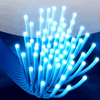
Fiber to the Antenna (FTTA) [SP6170]
Cell site Antenna is moving fast towards RRH and Active Antenna, and signalling is also changing to technologies such as LTE. So cell site feeder cable is increasingly moving to fiber optics. This course will provide a solid and detailed overview of fiber optic technology, CommScope's relevant fiber solutions, fiber theory, installation and testing.
Estimated study time: 6 hours 10 minutes
Overall content duration: 5 hours 35 minutes
Languages
The webcasts for this course are available in the following languages:
plus additional languages available for assessments.
Audience:
This course is suitable for, Installers, Design engineers, Project managers, Field engineers and anyone who works directly or indirectly with a wide area wireless communications system.
Pre-requisite experience:
There is no pre-requisite experience required for this course. SP6000 RF Fundamentals will provide you with a sound understanding of RF theory if you do not have any exposure to these wide area communications networks and antenna.
Objectives:
- Supply the tools and information to assist you in understanding fiber optic cabling technology
- Introduce you to the safety considerations both for OSP (OutSide Plant) and handling of fiber and equipment
- Ensure you gain a broad introduction to fiber theory in order to better understand the practical course topics
- Introduce CommScope's cables and connectivity
- Overview FTTA solutions
- Understand termination and splice methodology used with fiber and connectors
- Detail design, testing and installation requirements common to fiber optic systems
Key Topics:
- OSP Safety - Safety is the number one priority in any job. This lesson looks at example safety standards and considerations when installing OSP cables.
- Fiber Safety - Apart from the site installation safety requirements covered in Lesson 1a there are some additional risks with fiber that demand special care. In this lesson we explore the important considerations associated with handling fiber and their transmission systems.
- Fiber Transmission Theory - This lesson covers in detail the technical parameters of fiber optic cabling technology. We will look at some of the basic theory behind the propagation of light through optical fiber. Propagation of Light through an Optical Fiber, Index of Refraction, Refraction vs. Reflection, Numerical Aperture, Attenuation, Wavelength, Spectral Width, Tx Power and Rx Sensitivity, Dispersion, Bandwidth
- Fiber Types - This lesson covers in detail the technical parameters of relevant fiber types, and the technology behind them. You will gain an understanding of the basic manufacturing principals and introduce the Multimode Fiber types, followed by a look at Singlemode fiber types.
- Cable Design - This lesson covers in detail the design and construction of fiber optic cables to suit a wide variety of environments. It will include basic cable structure and design and OSP loose tube cable design.
- Connectors and Accessories - This lesson will cover Fiber optic connector design. This topic covers fiber optic connector technology, design, construction and use. In additiona we will look at CommScope's range of Transmission Line Products.
- FTTA Solutions - Introduces CommScope's history and heritage in the wired and wireless market. It goes on to introduce the trends in the Cell site technology, and the increase in FTTA (fiber to the Antenna).
- Fiber Splicing - This lesson covers in much more detail the process of fiber optic splicing. We will take the Lesson in two parts: Part 1 Splicing safety, fiber preparation and cleaving. Part 2 Fusion splicing techniques, process and equipment.
- Fiber Testing - This lesson covers in much more detail the process of fiber optic testing. We will take the Lesson in three parts: Part 1 Cleaning, Inspection and channel loss. Part 2 Optical Fiber Testing using a Light Meter and Source - Optical Loss Test Set (OLTS). Part 3 Optical circuit fault finding using an OTDR.
How will I learn?
You will study this course online in a self- paced format.
The course is made up of a number of webcast lessons and online multiple choice assessments giving immediate feedback.
Downloads include the Videos:
- SC and LC direct connector termination
- Qwik II connector termination - mechanical splice
- Fusion Splicing for joining fiber or adding pig-tail connectors
- Fiber Optic connector cleaning
Successful completion will require:
Any level of pass in the overall assessment score.
Is this the right course for me?
If you are an installer, field engineers, design engineers or project manager involved in cell site base station projects but need to know more about fiber optics then this course is for you.
Upon successful completion you will:
Receive a certificate that may be self-printed.
Course information:
Certificate valid for 3 years
Estimated study time: 6 hours 10 minutes
Overall content duration: 5 hours 35 minutes
Course Benefits
- Learn at your own pace
- Effective learning
- Learn on the go and on-site
- Cost effective
- Consistent training globally
- Available in many languages
- Access latest material